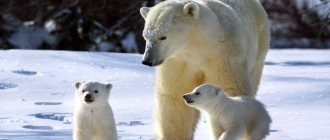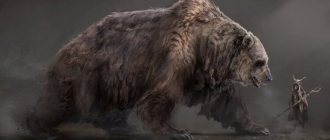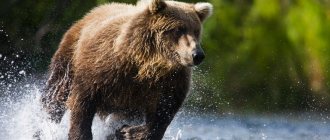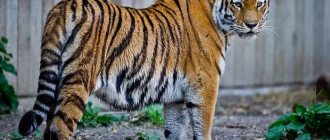The article explains:
- Polar bear lifestyle
- Is a polar bear really white?
- Interesting facts about the polar bear
- Places where you can see a polar bear
- Threats to polar bears in the Arctic
Polar bears of the Arctic are a symbol of this region.
A unique predator that can run at the speed of a car and swim faster than a person can walk. A bear can hear its prey almost a kilometer away. Despite all these abilities, this species is endangered and programs for its restoration are regularly carried out. However, this does not mean that a polar bear can only be seen in a zoo. In our article we will talk about where this predator is found, how it can be seen in its natural environment, and we will also talk about its habits and factors that negatively affect the population.
Polar bear habitats in the Arctic
Many people cannot immediately answer the question: do polar bears live in the Arctic or Antarctica? The bears' habitat is the Arctic - the polar regions of the northern hemisphere. The mammal is capable of living in permafrost conditions; for this it has a number of features. The habitat is extensive, starting from the island of Newfoundland in the south and extending to 88 degrees north latitude.
Polar bear habitats in the Arctic
The bear's mainland habitat is the Arctic deserts along with the tundras of Russia, Canada, Greenland and North America. The life activity of the animal is affected by seasonal changes in the ice boundaries in the Arctic.
Polar bears can be seen anywhere on the coast of Greenland. They inhabit the island of Spitsbergen, Novaya Zemlya and Franz Josef Land in the Barents Sea. In addition, they live on the islands of Kolguev, Medvezhiy, Vaygach and in the coastal areas of the Kara Sea. Individual populations of animals can be observed on the coasts of the Laptev and Beaufort seas, the East Siberian and Chukchi seas. But the majority of polar bears are found on the shores adjacent to the Arctic Ocean.
Polar bear habitats in the Arctic
Polar bears are “nomads”. They change their habitat depending on seasonal changes in the polar ice boundaries. In summer, they can often be found near the polar zone, and in winter - in the south, right up to the mainland. These animals, with rare exceptions, live on the ice near the coast. But, like brown bears, they hibernate in dens, which are built on the mainland or in the interior of the islands.
Hibernation lasts from one and a half to 2.5 months; it is usually observed in females expecting offspring. Other individuals, both male and female, spend less time in hibernation, and not every winter.
Description and features
This bear is larger than a lion and a tiger. Where are exotic predators compared to our Russian polar beast! Its length reaches 3 meters. Although most often 2-2.5 m. And the mass of a polar bear is almost half a ton. An adult male weighs 450-500 kg. Females are much smaller. Weight from 200 to 300 kg. Body length is from 1.3 to 1.5 m.
The height of an adult animal most often reaches 1.4 m. These dimensions correspond to the colossal strength of the animal. There are frequent examples when a bear easily carried away a large prey, a reindeer or a walrus.
Even more dangerous is the extraordinary agility of this beast, which is even difficult to believe considering its weight. His appearance is different from other bears. First of all, it's really white. More precisely, its fur ranges from white to light yellow. In winter it is lighter, in summer it turns yellow under the sun.
The polar bear in the photo looks more impressive against the backdrop of its native expanses. His appearance there almost merges with the ice hummocks, one black nose and eyes stand out against the general background. It becomes clear how advantageous the white color is in nature for this animal.
Unlike an ordinary bear, it does not have a stocky body, but a “runaway” one. Long neck, flat head, long and sensitive nose. There is evidence that it can smell the desired prey even under a meter-long layer of ice.
Nature generously took care of his “clothing”, given the harsh polar conditions. Its coat is thick and long, it has good thermal insulation properties. The fur is hollow and allows the rays of the sun to pass through.
And the skin under the fur is dark, and warms up better, retaining heat. The legs of the predator are very powerful, ending in large paws. The soles of his paws are lined with wool so that he does not slip on people and does not freeze.
There are membranes between the fingers, they help him swim. The front surface of the paws is covered with stiff bristles. Hidden underneath are large claws that allow you to grab and hold prey until you reach it with your teeth.
The jaws are large, well developed, with up to 42 teeth. The polar bear's tail is small, from 7 to 13 cm. It is practically invisible under the long hair on the back of the back.
The beast is distinguished by endurance and agility. Being a close relative of the brown bear, it is not nearly as clumsy. It can quickly and tirelessly run up to 6 km on land, accelerating up to 40 km/h, after patiently tracking down the victim. It sneaks up perfectly, deftly chooses the right moment, taking advantage of uneven ground, and attacks by surprise and quickly.
He swims and dives well. Can swim quite a distance, at speeds up to 7 km/h. Sailors traveling through the northern seas have repeatedly encountered polar bears swimming in the open sea far from the shores.
Let's add to all this the extraordinary courage of the polar owner and terrible ferocity, and it will become clear why in the northern latitudes all living things are afraid of this tyrant. Only the walrus, armed with long fangs, enters into a fight with the northern bear. And the man, picking up a firearm, also challenged the beast. Although, this was precisely one of the reasons for the catastrophic disappearance of this amazing animal.
Polar bear lifestyle
The polar bear is the only land-dwelling mammal that has adapted to life on Arctic ice. On average, a male bear weighs 430 kg, a female – about 370 kg. The maximum weight that could be recorded is 800 kg. The length of the animal reaches 2-2.5 meters, the height of the predator is up to one and a half meters.
Arctic bears lead an isolated lifestyle, walking alone. There are periods of forced aggregations in which hierarchical relationships are built. The polar bear of the Arctic is a fairly non-conflict animal, but in the fight for the attention of the female, during the rutting season, they can arrange fights.
The period of active ripening occurs in mid-March, the rut lasts one month. Bears quickly find a mate, but there are cases when a female is surrounded by the attention of two suitors at once. Female bears go to give birth alone, away from males, because... future "dads" may pose a threat to the little bear cub.
For the birth of her offspring, the mother bear sets up a den in the snow. As mentioned earlier, only females hibernate, while males can be active all year round.
The polar bear bears offspring for about 8 months, giving birth occurs in January-April. Up to three cubs can be born at once, but the first litter usually contains one cub. According to the laws of nature, in 20-30% of cases, newborn cubs do not survive. Their maximum birth weight does not exceed 800 grams. If you compare their size and the weight of the mother, newborns are just crumbs.
The cubs are born blind and deaf, they are completely dependent on the mother bear. For the first few days, the mother is next to her offspring in the den, curled up around the cubs. After about 30 days, the cubs begin to see and begin to hear. And after another month, they begin to leave their shelter together with their mother. Their cohabitation continues until puberty, which begins at 3-4 years.
Polar bear lifestyle
The polar bear of the Arctic feeds on fish, in particular the ringed seal. In addition, being a predator, it attacks seals and sea hares; and in the Chukchi Sea area - even on walruses. A hungry bear is able to walk several tens of kilometers on ice to get food. If necessary, he is ready to pursue prey at sea. Polar bears are quite smart; they track their prey, silently sneak up and attack. They can wait for the seal near the ice hole and climb into snow holes. If there is no fresh food, they will not refuse carrion, in the form of whale carcasses washed ashore.
Who was the first to reach the South Pole?
The first conquerors of the South Pole were the Norwegian explorer Roald Amundsen.
and British explorer
Robert Scott
, after whom the first station at the South Pole, the Amundsen-Scott station, was named. Both teams took different routes and reached the South Pole within a few weeks of each other, first by Amundsen on December 14, 1911, and then by R. Scott on January 17, 1912.
First flight over the South Pole
: American Richard Byrd, in 1928
First to cross Antarctica
without the use of animals or mechanical transport: Arvid Fuchs and Reinold Meissner, December 30, 1989
Is a polar bear really white?
White is the color common to most Arctic animals. Permafrost forces polar bears to wear a snow-white coat all year round. What is this connected with? The obvious answer is for camouflage. The white color of the fur helps it “merge” with the white ice of the Arctic, which ensures a successful hunt for the predator.
In addition to camouflage, white color helps them with thermoregulation. Polar animals live in conditions with reduced insolation, and the pigment melanin, which is responsible for coloring, prevents the penetration of UV rays. The skin of a bear, if it is devoid of pigmentation, transmits the sun's rays more actively. And melanin helps absorb harmful radiation, directing it to heating and other processes in the animal’s body. As a result, it turns out that weak insolation in the Arctic becomes an advantage for the polar bear.
But if you delve into the true color of the bear's skin, it turns out that it is not white. Its fur is completely devoid of pigment, and the hairs themselves are hollow inside. This feature is characteristic of all polar animals, for example, reindeer. This hair structure contributes to better thermal insulation. And the illusion of white skin color is formed due to the fact that the hair cavity inside is uneven - it refracts light rays at different angles, providing this color.
Another feature that helps the polar bear survive in the Arctic is the layer of sebum on its fur. Thanks to this, he literally gets away with it. Hunting and seasonal movements force him to plunge into icy water. The polar resident is an excellent swimmer: his speed in water can exceed 6 km/h, his stay under water is several minutes, and his maximum swim distance is 660 km.
Who was the first to reach the North Pole?
There have been several expeditions to the North Pole since the 18th century. There is disagreement over who was the first to reach the North Pole. In 1908, American explorer Frederick Cook became the first to claim to have reached the North Pole. But his compatriot Robert Peary
refuted this statement, and on April 6, 1909, he officially began to be considered the first conqueror of the North Pole.
First flight over the North Pole
: Norwegian traveler Roald Amundsen and Umberto Nobile on May 12, 1926 on the airship "Norway"
First submarine at the North Pole
: nuclear submarine Nautilus 3 August 1956
First trip to the North Pole alone
: Japanese Naomi Uemura, April 29, 1978, sledding 725 km in 57 days
First ski expedition
: expedition of Dmitry Shparo, May 31, 1979. Participants covered 1,500 km in 77 days.
First to swim across the North Pole
: Lewis Gordon Pugh walked 1 km in -2 degrees Celsius water in July 2007.
This is interesting: Who was the first to prove that the Earth is spherical?
Unique facts about the polar bear
The polar bear has won the attention of people who have created a large number of legends and stories about it. Here are reliable facts about this polar animal that will surely interest many lovers of Arctic polar nature:
- A population of small individuals has been recorded on the island of Spitsbergen and areas nearby, while larger animals have chosen the Barents Sea.
- If you take photographs under UV lighting, the polar bear will turn into a “black” one.
- Hunger forces bears to travel vast distances on land and in water. This is their similarity with their brown counterparts. A case was recorded when a polar bear swam in the Beaufort Sea, which lasted more than 9 days without stopping. The female traveled 660 km, losing 22% of her body weight and her cub. She herself survived and made her way ashore on her own.
- The Arctic bear is fearless, capable of attacking a person, making him its prey. If hunger forces him, it will haunt him for several days. In the province of Manitoba, the city of Churchill in Canada, there is a special shelter for bears that have strayed into the settlement. They are placed there for a while, this is a necessary measure. A predator can easily enter a people’s home, driven by severe hunger. After it is fed and allowed to rest, the animal is released and it leaves the person’s place of residence. This approach gives hope that the predator will not return to them soon.
- Eskimos believe that the white resident of the Arctic is the embodiment of the power of nature. A man can earn this right by defeating a bear in a fair fight.
- Previously existing giant polar bears are the ancestors of the modern representative of the Arctic.
- The bear, weighing just over a ton, was shot and killed in Alaska in 1962.
- The polar bear is a warm-blooded animal. His body temperature is about 30C. This prevents him from moving quickly. Running for long periods of time can cause your body to overheat.
- Children usually receive their first knowledge about the existence of polar bears after watching cartoons such as “Umka”, “Elka” and “Bernard”.
- The image of this animal is present on the wrappers of the “Bear in the North” sweets.
- February 27th became the official polar bear day.
- The polar bear is the symbol of Alaska.
Unique facts about the polar bear
There used to be a nuclear power plant in Antarctica
Now McMurdo Station is the largest settlement, port, transport hub and research center in Antarctica. Belongs to the US Antarctic Program since 1962, but also serves stations and research programs of other countries.
This is interesting: Life expectancy of mosquitoes, reasons for appearing in the house and ways to combat them
Where in the Arctic can you see a polar bear?
Polar bears live in the Arctic, being born on land, they spend most of their lives on ice floes in sea waters. They are extremely rare for people, since people do not live in those parts of the Northern Hemisphere. But there are areas where you can meet a polar bear, and in its natural habitat.
- Canada, province of Manitoba, city of Churchill
This place comes to the fore in terms of the likelihood of seeing and observing an Arctic resident. The city is considered the unofficial capital of the Polar Bear. There are many companies that organize trips to Churchill. They are responsible for the safety of the participants and the animals themselves. This is a unique place where everyone can not only see a polar bear in the wild, but also photograph it.
- Norway, Spitsbergen
This Norwegian island lies far to the north, almost at the same latitude as the top of Greenland. In those parts there is an excellent opportunity to see the Arctic polar bear from the sea, while on a ship. Such an encounter guarantees the safety of travelers when encountering a wild animal.
In addition to the opportunity to watch the bear from a ship, there are nature reserves and wildlife sanctuaries on the Spitsbergen archipelago. You can also go there if you wish: sightseeing and educational excursions are held there in a group or individually. The organization is aimed at the safety of travelers, and also to ensure that their curiosity does not harm the livelihoods of animals.
Where in the Arctic can you see a polar bear?
- Russia, Wrangel Island
The place has its own peculiarity - it is isolated from the active participation of people, so no one or anything bothers the bears. This is the most remote part of Russia and the polar bear of the Arctic lives there in an absolutely wild environment.
When a polar whale washed ashore in the fall of 2022, more than two hundred bears gathered around it, eager to dine on carrion. Therefore, the likelihood that you will definitely meet a predator is huge.
Excursions to the island began to be organized in 1993. They are carried out on snowmobiles to get closer to the bear. Although this increases the risk of meeting him closely.
Restless tourist
When pack ice grows in the Arctic, the real hunting season begins. Hunting season begins. There are a few cracks and ice holes left for seals and fish to take a breath of air. The bear calmly waits, waiting for the victim, knocks out and catches a fish with its paw. In the entire frozen water desert, a better hunter cannot be found.
Carnivores are on the move all year round, on drifting ice and on the coast in search of prey. They usually do this as a lone wolf.
This is interesting: Is it possible to give hamsters carrots?
What poses a threat to the life of polar bears in the Arctic?
The polar bear is not only one of the largest predatory mammals, it is also a beautiful and noble animal. According to researchers, today there are about 30 thousand of them living in the Arctic. But in 25-30 years their numbers may be reduced by one third. What factors can affect this:
- Illegal extermination . Despite restrictions and a number of security measures, poaching is flourishing. Polar bear skin is highly valued on the black market, so poachers are not stopped by laws, high fines and the threat of imprisonment.
- Changes in climate . Global warming has a strong impact on the melting of Arctic glaciers, the area of which is decreasing every year. American scientists in their studies came to the conclusion that in the next 10 years the size of polar glaciers could decrease by 40%. But the ice of the Arctic is the habitat of polar bears. Scientists believe that the current percentage is 25, but the figure is clearly underestimated.
- Environmental pollution . This factor is taken into account not only throughout the planet, but its negative impact on the polar lands is also considered. In particular, pollution with pesticides, heavy metals, radionuclides, and waste from combustion of fuels and lubricants is taken into account. All these processes are the result of human activity. The polar bear lives up to 30 years, and during this time it is exposed to toxic ingredients.
If you understand the situation and understand the influence that humans have on the Arctic environment, then it becomes dangerous for the continued existence of not only the polar bear, but also the entire animal world of the Arctic. If you delve into the question a little deeper, it becomes obvious that the people in this chain are next. By mindlessly destroying nature, we kill ourselves.
NFR website editors











